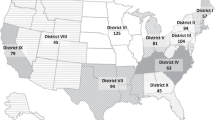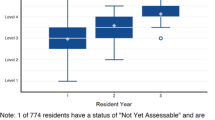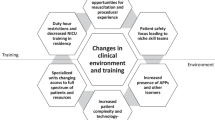Abstract
Neonatal-perinatal medicine (NPM) fellowship training aims to educate fellows and enable them to move into successful independent neonatal practice. To reach this goal, every fellow must acquire a wide range of clinical, scholarly, and professional skills that require assessment and evaluation by the fellowship program. The assessment and evaluation of fellow progression and promotion must rely on a rigorous educational framework. The goal of this article is to illustrate the process of NPM fellow assessment and evaluation, introduce the educational framework utilized, describe challenges inherent to the process, and discuss opportunities to improve how NPM fellows are evaluated.
This is a preview of subscription content, access via your institution
Access options
Subscribe to this journal
Receive 12 print issues and online access
$259.00 per year
only $21.58 per issue
Buy this article
- Purchase on SpringerLink
- Instant access to full article PDF
Prices may be subject to local taxes which are calculated during checkout



Similar content being viewed by others
References
Starr S. Moving from evaluation to assessment. J Med Libr Assoc JMLA. 2014;102:227–9.
Van Melle E, Frank JR, Holmboe ES, Dagnone D, Stockley D, Sherbino J. A Core Components Framework for Evaluating Implementation of Competency-Based Medical Education Programs. Acad Med. 2019;94:1002–9.
Chaney KP, Hodgson JL. Using the Five Core Components of Competency-Based Medical Education to Support Implementation of CBVE. Front Vet Sci. 2021;8:689356.
Gillam-Krakauer M, Sharma J, Myers P, ONTPD Fellowship Directors Writing Group, Bonachea EM. Part 6: Essentials of Neonatal-Perinatal Medicine fellowship: program administration. J Perinatol Off J Calif Perinat Assoc. 2022;42:976–81.
Carbajal MM, Dadiz R, Sawyer T, Kane S, Frost M, ONTPD Fellowship Directors Writing Group. et al. Part 5: Essentials of Neonatal-Perinatal Medicine Fellowship: evaluation of competence and proficiency using Milestones. J Perinatol. 2022;42:809–14.
Gray MM, Bruno C, French H, Myers P, Carbajal MM, Reber KM, et al. Changes, Challenges, and Variations in Neonatal-Perinatal Medicine Fellowship: A View from the Program Directors. Am J Perinatol. 2024;41:e163–73.
Schumacher DJ, Michelson C, Winn AS, Turner DA, Elshoff E, Kinnear B. Making prospective entrustment decisions: Knowing limits, seeking help and defaulting. Med Educ. 2022;56:892–900.
Ross S, Binczyk NM, Hamza DM, Schipper S, Humphries P, Nichols D, et al. Association of a Competency-Based Assessment System With Identification of and Support for Medical Residents in Difficulty. JAMA Netw Open. 2018;1:e184581.
Berlin KEK, Gray MM, Myers PJ, Scheurer JM, Robin B, McLean C, et al. A new era of assessment for neonatal-perinatal medicine trainees: milestones 2.0. J Perinatol. 2023;43:1506–12.
Czaja AS, Mink RB, Herman BE, Weiss P, Turner DA, Curran ML, et al. Exploring Factors for Implementation of EPAs in Pediatric Subspecialty Fellowships: A Qualitative Study of Program Directors. J Med Educ Curric Dev. 2024;11:23821205231225011.
Ekpenyong A, Padmore JS, Hauer KE. The Purpose, Structure, and Process of Clinical Competency Committees: Guidance for Members and Program Directors. J Grad Med Educ. 2021;13:45–50.
Kerth JL, Bosse HM. The Future of Postgraduate Training? An Update on the Use of Entrustable Professional Activities in Pediatric Professional Training. Acad Pediatr. 2024;24:1035–7.
Langhan ML, Boyer DL, Hsu D, Moffatt ME, Pitts SA, Atlas MP, et al. Implementing Entrustable Professional Activities in Pediatric Fellowships: Facilitating the Process. Pediatrics. 2024;153:e2023065024.
Schut S, Maggio LA, Heeneman S, Van Tartwijk J, Van Der Vleuten C, Driessen E. Where the rubber meets the road — An integrative review of programmatic assessment in health care professions education. Perspect Med Educ. 2020;10:6–13.
ABP. ABP - For Program Directors. 2024. Available from: https://www.abp.org/content/program-directors.
ABP. Next Steps for Training Programs - ABP. American Board of Pediatrics. Available from: https://www.abp.org/content/next-steps-training-programs.
Liu L, Jiang Z, Qi X, Xie A, Wu H, Cheng H, et al. An update on current EPAs in graduate medical education: A scoping review. Med Educ Online. 2021;26:1981198.
Meyer EG, Chen HC, Uijtdehaage S, Durning SJ, Maggio LA. Scoping Review of Entrustable Professional Activities in Undergraduate Medical Education. Acad Med. 2019;94:1040–9.
Kim ME, Tretter J, Wilmot I, Hahn E, Redington A, McMahon CJ. Entrustable Professional Activities and Their Relevance to Pediatric Cardiology Training. Pediatr Cardiol. 2023;44:757–68.
Sterkenburg A, Barach P, Kalkman C, Gielen M, ten Cate O. When do supervising physicians decide to entrust residents with unsupervised tasks? Acad Med J Assoc. Am Med Coll. 2010;85:1408–17.
Dijksterhuis MGK, Voorhuis M, Teunissen PW, Schuwirth LWT, ten Cate OTJ, Braat DDM, et al. Assessment of competence and progressive independence in postgraduate clinical training. Med Educ. 2009;43:1156–65.
Hauer KE, Ten Cate O, Boscardin C, Irby DM, Iobst W, O’Sullivan PS. Understanding trust as an essential element of trainee supervision and learning in the workplace. Adv Health Sci Educ Theory Pract. 2014;19:435–56.
Gourevitch MN, Malaspina D, Weitzman M, Goldfrank LR. The public hospital in American medical education. J Urban Health Bull N Y Acad Med. 2008;85:779–86.
Turner DA, Schwartz A, Carraccio C, Herman B, Weiss P, Baffa JM, et al. Continued Supervision for the Common Pediatric Subspecialty Entrustable Professional Activities May Be Needed Following Fellowship Graduation. Acad Med. 2021;96:S22–8.
Dickey CC, Thomas C, Feroze U, Nakshabandi F, Cannon B. Cognitive Demands and Bias: Challenges Facing Clinical Competency Committees. J Grad Med Educ. 2017;9:162–4.
McLean S, Edgar L, Harsy B. The Milestones 2.0 Development Process. J Grad Med Educ. 2021;13:4–7.
ABP. Entrustable professional activities for subspecialties. American Board of Pediatrics; 2024. Available from: https://www.abp.org/content/entrustable-professional-activities-subspecialties.
The Accreditation Council for Graduate Medical Education (ACGME). ACGME Program Requirements for Graduate Medical Education in Neonatal-Perinatal Medicine. 2020. Available from: https://www.acgme.org/globalassets/pfassets/programrequirements/329_neonatalperinatalmedicine_2020.pdf.
ACGME. ACGME Program Search. ACGME. 2023. Available from: https://apps.acgme.org/ads/Public/Programs/Search.
ACGME. Specialty-Specific Program Requirements: Program Leadership Dedicated Time. ACGME. 2023. Available from: https://www.acgme.org/globalassets/pdfs/specialty-specific-requirement-topics/dio-dedicated_time_program_leadership_102023.pdf.
Ewen AM, Higgins MCSS, Palma S, Whitley K, Schneider JI. Residency and Fellowship Program Administrator Burnout: Measuring Its Magnitude. J Grad Med Educ. 2019;11:402–9.
O’Connor AB, Halvorsen AJ, Cmar JM, Finn KM, Fletcher KE, Kearns L, et al. Internal Medicine Residency Program Director Burnout and Program Director Turnover: Results of a National Survey. Am J Med. 2019;132:252–61.
Khesroh E, Butt M, Kalantari A, Leslie DL, Bronson S, Rigby A, et al. The use of emotional intelligence skills in combating burnout among residency and fellowship program directors. BMC Med Educ. 2022;22:127.
Acknowledgements
We are grateful to David A. Turner MD for his leadership of the ABP NPM EPA to Milestones 2.0 mapping project, his willingness to provide insightful feedback on this manuscript and for his commitment to partnering with the NPM fellowship PDs to further the development of NPM fellow training.
Author information
Authors and Affiliations
Contributions
CM – Drafted the first text, created all tables and figures, helped with study design and implementation and edited the final manuscript. BR – Contributed to the initial conception of the paper, helped with the initial creation of tables and figures, helped with study design and implementation and edited the final manuscript. JS – Contributed to the initial conception of the paper, helped with the initial creation of tables and figures, helped with study design and implementation and edited the final manuscript. KB – Contributed to the initial conception of the paper, helped with study design and implementation and edited the final manuscript. MG – Contributed to the initial conception of the paper, helped with study design and implementation and edited the final manuscript DO – Contributed to the initial conception of the paper, helped with study design and implementation and edited the final manuscript. HF - Contributed to the initial conception of the paper, helped with study design and implementation and edited the final manuscript. MV – Contributed to the initial conception of the paper, helped with study design and implementation and edited the final manuscript. MC – Contributed to the initial conception of the paper, helped with study design and implementation and edited the final manuscript. KR – Contributed to the initial conception of the paper, helped with study design and implementation and edited the final manuscript. LJ – Contributed to the initial conception of the paper, helped with study design and implementation and edited the final manuscript. PM – Contributed to the initial conception and writing of the paper, helped with the initial creation of tables and figures, helped with study design and implementation and coordinate the final edits to the manuscript.
Corresponding author
Ethics declarations
Competing interests
The authors declare no competing interests.
Additional information
Publisher’s note Springer Nature remains neutral with regard to jurisdictional claims in published maps and institutional affiliations.
Rights and permissions
Springer Nature or its licensor (e.g. a society or other partner) holds exclusive rights to this article under a publishing agreement with the author(s) or other rightsholder(s); author self-archiving of the accepted manuscript version of this article is solely governed by the terms of such publishing agreement and applicable law.
About this article
Cite this article
McLean, C., Robin, B., Scheurer, J.M. et al. Neonatology fellow assessment and evaluation: embracing the word salad of CBME, EPAs, and milestones. J Perinatol 45, 572–579 (2025). https://doi.org/10.1038/s41372-024-02208-7
Received:
Revised:
Accepted:
Published:
Issue date:
DOI: https://doi.org/10.1038/s41372-024-02208-7



